The concept of a Cat Bunny, often referred to as a “cabbit,” has captivated and confused people for generations. While the idea of a hybrid between a cat and a rabbit might seem biologically improbable, persistent anecdotes, eyewitness accounts, and even videos suggest that something unusual might be happening. Could these “cabbits” be real animal hybrids, or are they simply cases of mistaken identity or elaborate hoaxes?
Despite the lack of definitive genetic confirmation, the phenomenon of the cat bunny is surprisingly well-documented, perhaps even more so than some other claimed animal crosses that might initially appear more plausible, such as cat-dog or cat-raccoon hybrids. Numerous videos purportedly showing cat bunny hybrids and countless firsthand reports fuel the ongoing debate.
One compelling example often cited is a creature from Tucuman, Argentina. Videos circulating online seem to depict an animal with the distinct front half of a cat seamlessly blending into the rear half of a rabbit. Adding to the intrigue, this creature reportedly moves like a rabbit, hopping rather than walking like a cat.
Article continues below
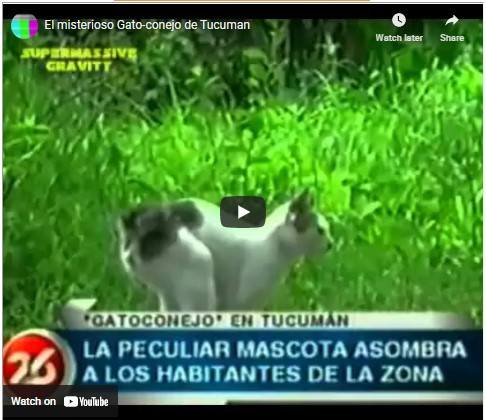 Animal resembling a cat at the front and a rabbit at the rear, hopping, in Tucuman, Argentina.
Animal resembling a cat at the front and a rabbit at the rear, hopping, in Tucuman, Argentina.
Explore more cabbit videos >>
Read reports describing cabbits >>
The Cabbit Conundrum: Fact or Fiction?
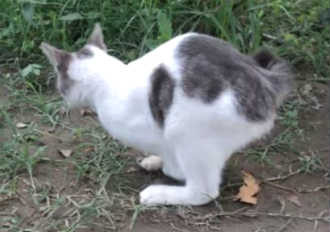 Picture of the Tucuman cabbit showing plantigrade hind feet.
Picture of the Tucuman cabbit showing plantigrade hind feet.
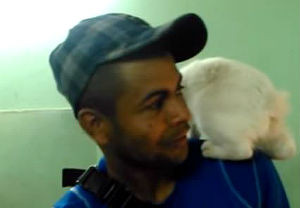 Screenshot from a cabbit video showing rabbit-like hindquarters and cat-like forequarters.
Screenshot from a cabbit video showing rabbit-like hindquarters and cat-like forequarters.
The very notion of cat bunnies has been met with skepticism and outright dismissal by many. Historically, naturalists like Francis Trevelyan Buckland, in the 19th century, attributed supposed cabbit sightings to Manx cats with birth defects. Buckland famously quipped about the need for “a rabbit with a long tail” to prove the hybrid theory, highlighting the prevailing disbelief.
However, proponents of the cat bunny phenomenon vehemently assert their reality. Sarah Hartwell, an author who wrote an article arguing against the possibility of cabbits, recounted receiving a passionate email from a believer claiming, “Cabbits are real, I have had them and bred them and they are abundant in Ontario… They have soft fur like the rabbit, look like a cat except they have the hind legs of the rabbit, they are silent, don’t meow and they kind of hop/walk.” This illustrates the strong convictions held by those who believe in cat bunny hybrids.
Article continues below
 Frontal view of a cabbit-like animal with cat-like face and rabbit-like body proportions.
Frontal view of a cabbit-like animal with cat-like face and rabbit-like body proportions.
The debate surrounding cat bunnies often descends into accusations of ignorance or dishonesty from both sides. Initially, even researchers were inclined to dismiss the idea of such a distant hybrid. However, the proliferation of videos on platforms like YouTube showcasing animals that resemble cabbits has prompted reconsideration. The lack of genetic testing remains a significant hurdle in definitively resolving the question, as no laboratory with the necessary resources has yet undertaken such an analysis.
One undeniable fact that lends some credence to the possibility is the documented observation of male rabbits (bucks) attempting to mate with female cats. This behavior, extensively captured in videos online, demonstrates a degree of interspecies interaction that could potentially lead to hybridization, however unlikely. Furthermore, numerous videos compiled online display animals exhibiting rabbit-like hindquarters and a hopping gait, combined with distinctly feline front portions. Are these simply Manx cats with deformities, or could they genuinely be cat-rabbit hybrids? The evidence certainly suggests the need for further scientific inquiry. If these animals are indeed hybrids, genetic analysis would readily confirm this, especially if they are first-generation (F₁) hybrids. Later generation hybrids resulting from backcrossing might present more complex DNA evaluation challenges.
Interestingly, there are documented instances of cats nursing and raising rabbits. This phenomenon of cross-species nurturing can lead to “imprinting,” where animals raised by a different species may, upon reaching sexual maturity, prefer mating with that foster species rather than their own. This imprinting could theoretically increase the chances of hybridization. The following video captures a cat nursing rabbits:
Article continues below
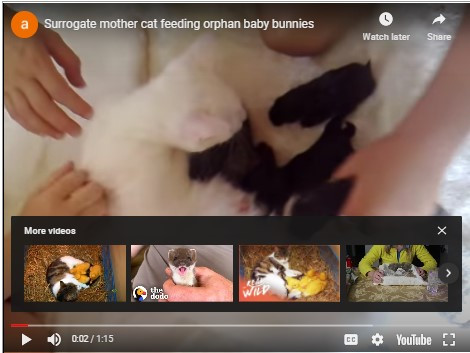 Cat nursing a litter of rabbits, showcasing interspecies nurturing behavior.
Cat nursing a litter of rabbits, showcasing interspecies nurturing behavior.
Rabbits raised by cats might, therefore, be imprinted on cats and attempt to mate with them as adults, a crucial prerequisite for cat bunny production – if such hybrids are biologically feasible.
Concerning Manx cats, if their unique characteristics are indeed rooted in hybridization (as some theories suggest), the rabbit ancestor would likely be the European rabbit (Oryctolagus cuniculus), the only rabbit species native to the Isle of Man, where Manx cats originated. Regarding the various alleged cat bunnies featured in online videos, the specific rabbit species involved remains unclear. However, the European rabbit, known for its invasive nature, has been introduced to numerous regions worldwide, and various domestic rabbit breeds closely related to the European rabbit are popular pets, increasing the potential for interaction with domestic cats.
Debunking the Impossibility: Why Cat Bunny Hybrids Are Dismissed
Lubbock Evening Journal – Lubbock, Texas – May 27, 1953: A news snippet from the past highlights the enduring fascination with cabbits: “CABBIBT—Mrs. Norm Weiler of St. Petersburg, Fla., has a new pet, but she’s not sure what it is. The animal has the head and shoulders of a cat, and the body of a rabbit, while its voice is half growl, half meow. Mrs. Weiler, who adopted the creature when it wandered into her yard recently, calls her new pet ‘Cabbit.’ She says it hates fish, loves cabbage and roast veal.” Such reports, often accompanied by photos of unusual animals, contribute to the ongoing mystery.
Chromosomal Differences: A primary argument against the possibility of cat bunnies centers on chromosome incompatibility. Cats possess 38 chromosomes (2n=38), while rabbits have 44 (2n=44). It’s often claimed that this difference in chromosome number renders hybridization impossible. However, this assertion is contradicted by numerous documented cases of successful hybridization between mammalian species with even greater chromosomal disparities. This website itself provides evidence of various such crosses. For example, sheep and goats, whose chromosome numbers differ by six (the same difference as between cats and rabbits), are known to produce hybrids on occasion.
Addressing Common Misconceptions:
Twitter Inquiry: “But do cabbits eat carrots or fish?” Response: “Most enjoy a nice mouse and tuna casserole with plenty of lettuce and carrots, and perhaps a light, re-ingestible pellet topping.”
(On a more serious note, observing videos of alleged cabbits reveals some consuming carrots and avocado, suggesting a potentially varied diet.)
Gestation Period Discrepancies: Another frequent argument against cat bunny hybrids involves the difference in gestation periods. Cats have a gestation period of approximately 64 days, while rabbits gestate for around 31 days. This roughly month-long difference is often cited as an insurmountable barrier to hybridization. This claim, however, is an age-old notion, dating back to Pliny the Elder in the 1st century AD. Numerous counter-examples in the animal kingdom disprove this theory. The cama, a hybrid of a dromedary camel (13-month gestation) and a llama (11-month gestation), and the wolphin, a hybrid of a false killer whale (15.5-month gestation) and a bottlenose dolphin (11.5-month gestation), are well-documented examples. In the wolphin’s case, the gestation periods differ by a significant four months, far exceeding the cat-rabbit difference. Domestic pigs (115-day gestation) and babirusas (150-157 day gestation) also hybridize despite a 33% difference in gestation length, similar to the dolphin-false killer whale disparity. These examples demonstrate that differences in gestation periods do not necessarily preclude hybridization, debunking this common myth.
| Cabbit Mentions in Popular Culture— by Chris Millar Buck rabbit cat Rabbit bucks cat Buck Rogers cat |
|---|
Genetic Divergence: A third argument posits that cats and rabbits are simply too “genetically different” to produce viable hybrids. While it’s true that hybrid crosses involve genetically distinct parents, the precise degree of genetic difference that prevents hybridization remains unknown, as does the specific nature of these prohibitive genetic differences. This is a complex area of genetics with ongoing research.
Anatomical and Evolutionary Differences: The argument extends to anatomical and evolutionary disparities. It’s suggested that cats and rabbits are too different in their anatomy and evolutionary history to hybridize. However, hybridizing species often exhibit anatomical differences, and the limits of anatomical divergence in successful hybridization are not fully understood. Similarly, the degree of evolutionary relatedness necessary for hybridization is also undefined. The cat bunny case itself might offer insights into these limits.
 Artistic representation of a cat-rabbit hybrid, illustrating the combined features.
Artistic representation of a cat-rabbit hybrid, illustrating the combined features.
Fertility Fallacy: Regarding the specific case of cat bunnies and Manx cats, some argue that because Manx cats are a recognized breed and can reproduce, they cannot be hybrids, as hybrids are typically sterile. This argument relies on false assumptions. Many documented hybrid crosses produce fertile or partially fertile offspring. Furthermore, numerous fertile domestic breeds are known to have originated through hybridization. Therefore, the fertility of Manx cats does not automatically negate the possibility of a hybrid origin.
The Enigmatic “Manx Gene”: Interestingly, Manx cats are not as fertile as typical domestic cats. They experience a higher rate of offspring inviability, a characteristic often associated with hybrids. This reduced viability is attributed to the “Manx gene.” However, no formal scientific study has definitively characterized or mapped this gene to a specific chromosome.
Article continues below
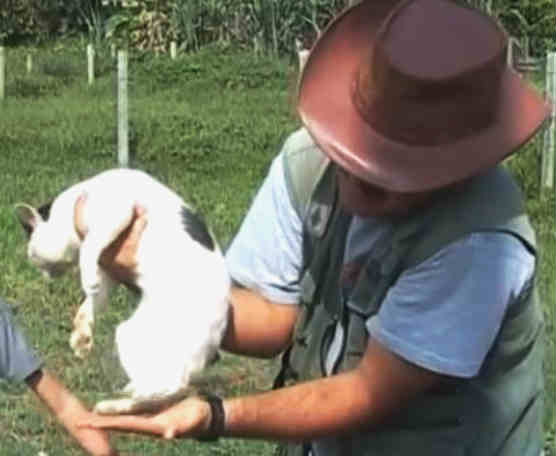 Another view of a cabbit-like animal, showcasing its unusual morphology.
Another view of a cabbit-like animal, showcasing its unusual morphology.
A Genetic Quandary— by Gene McCarthy
Two gametes meet, a hopeful start,
Their chromosomes, a work of art.
Will they combine, a brand new being?
Genetic dice, forever freeing.
It’s been observed that mating tailless Manx cats with each other results in a higher incidence of inviable offspring compared to mating a tailless Manx with a tailed Manx. Research suggests that conditions like spina bifida, incontinence, and pelvic limb locomotor disturbances are linked to the tailless trait in Manx cats. However, an alternative interpretation could be that tailless Manx cats represent first-generation (F₁) cat-rabbit hybrids, while tailed Manx cats are backcrosses with purebred cats. In many hybrid crosses, mating F₁ hybrids with backcross hybrids can indeed increase offspring viability compared to F₁-F₁ pairings.
Conclusion: A Question of Plausibility
While mutation can explain the unique traits of Manx cats without invoking rabbit ancestry, such an explanation requires a series of coincidences. One must assume that mutation alone caused the Manx’s posterior to resemble a rabbit’s, including the short tail, hopping legs, and blunt claws. Mutation would also need to explain the Manx’s reported preference for rabbit-like foods like carrots and lettuce. Furthermore, the health issues associated with Manx cats would have to be attributed to coincidental side effects of these mutations – mutations that remain genetically uncharacterized. Finally, one would have to believe that breeders could, through selective breeding of ordinary cats, replicate rabbit-like hindquarters through unknown genetic changes.
This accumulation of coincidences strains credulity. Is it not more straightforward and plausible to consider that Manx cats exhibit rabbit-like traits, reduced fertility, and hybrid-associated health issues precisely because they are, in fact, cat-rabbit hybrids? To paraphrase Samuel Johnson, when faced with an improbable scenario and a simpler explanation, “it is clear how he got into a different room: he was carried.”
This exploration of cat bunnies is part of a broader investigation into animal hybridization, further detailed in the book Telenothians.
Explore more cabbit videos >>
Read reports describing cabbits >>
Reported Cat Crosses: A Spectrum of Possibilities
The following list presents reported cat crosses, ranging from well-documented to seemingly impossible. The reliability of these crosses varies significantly.
Sheep-Pig Hybrids?
| ![reliability arrow]() |
|---|
Cat × Wildcat >>
Lion × Tiger >>
Jaguar × Lion >>
Leopard × Lion >>
Jaguar × Leopard >>
Cat × Pallas’s Cat >>
Cat × Rabbit (Cabbits) >>
Cat × Marten >>
Leopard × Tiger >>
Cat × Dog >>
Cat × Raccoon >>
Cat × Possum>>
Cat × Chicken >>
Cat × Kangaroo>>
Puma × Bear >>
Puma × Dog >>
Cat × Duck >>
Cat × Human >>
Cat × Rat >>
Cat × Opossum >>
Cat × Squirrel >>
Cat × Horse >>
| Most Shared on Macroevolution.net: Human Origins: Are we hybrids? On the Origins of New Forms of Life Mammalian Hybrids Cat-rabbit Hybrids: Fact or fiction? Famous Biologists Dog-cow Hybrids Georges Cuvier: A Biography Prothero: A Rebuttal Branches of Biology Dog-fox Hybrids |
|---|
Cat-rabbit Hybrids – © Macroevolution.net

